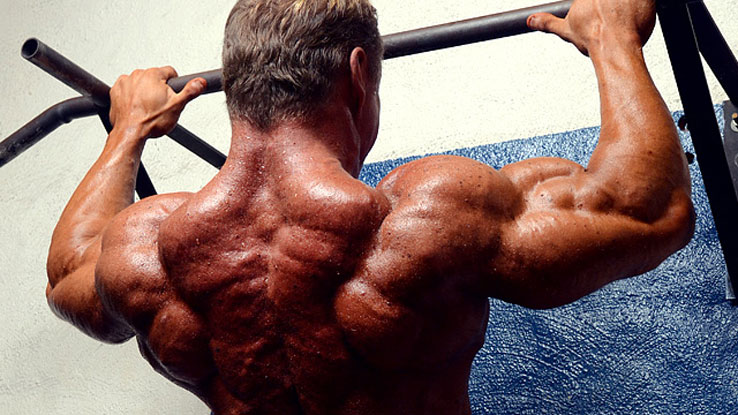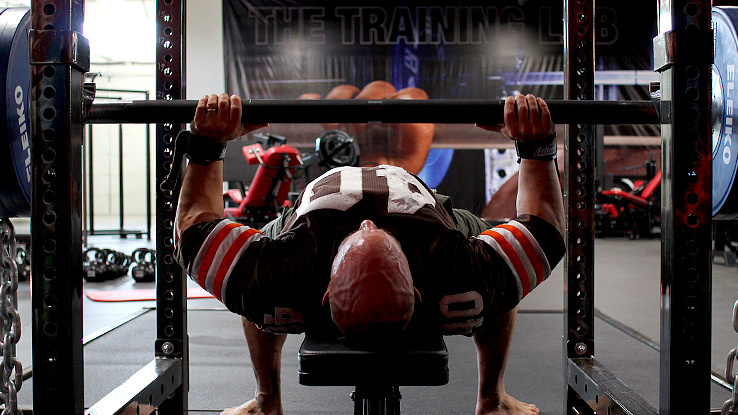Whenever you're dealing with a lagging body part or lift, the solution usually involves simply paying more attention to the stubborn area.
As weightlifting coach John Broz said:
"If your life depended on adding 100 pounds to your squat in three months, do you think you'd start training it less or more?"
The method I'll introduce to you here is a smart, elegant way of training "it" more.
Very simply, the essence of the hub and spoke method is that one lift becomes the "hub," and then you'll add 3-5 exercises that become the "spokes."
The hub is either an exercise you're trying to bring up or an exercise designed to target a lagging muscle group. The spokes are (ideally) exercises that target different muscle groups so as to minimize redundancy between the hub exercise and the spoke exercises.
As a simple example of a hub and spoke workout, let's assign chins as the hub, and we'll use three spoke exercises:
- Back Extensions
- Triceps Extensions
- Calf Raises
For reps, there are no hard and fast rules, but as you'll see in just a moment, you'll end up doing one and a half times as many sets for the hub exercise as you'll do for each spoke, so take that into consideration when you're considering rep assignments.
In this example, we'll do chins for sets of 5, and each spoke exercise will be performed for sets of 10. Here's what the first round will look like:
- Set 1: 5 Chins
- Set 2: 10 Back Extensions
- Set 3: 5 Chins
- Set 4: 10 Triceps Extensions
- Set 5: 5 Chins
- Set 6: 10 Calf Raises
By now you can visualize the hub and spoke arrangement. You start at the hub, and then proceed to one spoke, and then back to the hub, then to the next spoke, and so on. I also like the fact that the hub symbolizes something of central importance.
In terms of how many rounds you should do, think about how many sets were performed in the first round, which is related to how many spokes you're using. In this example, 3 rounds amounts to 18 work sets. Assuming 3 minutes of rest between each set and perhaps 30 seconds for each set itself, you're looking at a 63-minute workout after warm-ups.
Here's an example of a weekly training cycle utilizing the hub and spoke arrangement for the developmental phases of a competitive powerlifter. It'll be easy to apply this concept to your own training with just a bit of imagination, regardless of your personal goals or sport aspirations.

Monday
- Hub: Squat
- Spoke 1: Chin-up
- Spoke 2: Lying Dumbbell Triceps Extension
- Spoke 3: Hammer Curl
Wednesday
- Hub: Bench Press
- Spoke 1: Back Extension
- Spoke 2: Barbell Hip Thrust
- Spoke 3: Kettlebell Swing
Friday:
- Hub: Deadlift
- Spoke 1: Dumbbell Row
- Spoke 2: Military Press
- Spoke 3: Barbell Curl
- This type of training week is best applied during developmental phases of training as opposed to peaking phases. The rationale for this hinges on the possible coordinative disruption that might be caused by performing heavy/fatiguing sets of unrelated exercises between each set of a competitive lift. In the off season however, this wouldn't be much of a concern.
- In the example above, I've chosen to use "opposing" spoke exercises in each workout for two reasons. First, it reduces fatigue specificity between the spoke and hub exercises. In other words, the fatigue generated from any given spoke set will have minimal negative effect on the subsequent hub set. Secondly, using opposing exercises allows for three whole-body sessions per week, which allows you to work most muscles three times each week.
- Spoke exercises should be carefully chosen based on their ability to advance you toward your goals. Specifically, they should address weaknesses or shortcomings that aren't adequately addressed by the hub exercises. Such weaknesses might involve sticking points in each competitive lift, and/or weak, underdeveloped muscle groups.
- Depending on your personal training philosophy, the hub exercises can be done using either Maximal Effort or Dynamic Effort parameters. Or, you can actually rotate parameters for the hub exercise each week. For example, week one might be Maximal Effort, week two Dynamic Effort, and week three, Repeated Effort.
- The spoke exercises are generally higher rep or repeated effort in order to minimize warm-up sets and also to create some metabolic contrast to the hub exercise.However, there are instances when a spoke exercise can be performed with low(er) reps. When sorting out these decisions, simply consider the pros and cons of each approach, and then decide accordingly.




